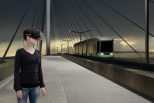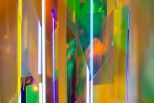"Forest of Light" installation that explores the idea of interaction and perspective; the darkened space is lit by towering…

The English artist Liz West in his latest site specific work explores light and color.
Always her installations create vivid environments with a mix of bright color and radiant light. Working with a variety of means, the West tries to cause increased sensory awareness through his works. Liz is interested in exploring the sensations and emotions that trigger in our minds while we come into contact with the concept of color. The research carried out in this respect reveal how the relationship between color and light are intimately connected.

Through No. 3 the English artist proposes a public art installation of six meters long, triangular steel Prism, polycarbonate and optically transparent vinyl, designed to be crossed, which was located on Crowne Square in Spinningfields, Manchester. Initially the installation had to remain only temporarily, but given the huge public success and the positivity of the relationship between the work and the public, will be on display indefinitely.
Within the architectural space, West uses light as a material which radiates outside its borders. The light refracts through translucent, transparent or reflective materials that express the flows of artificial light, in fact our understanding of color can be achieved only through the presence of light.

Playing and by adjusting the color, West highlights the intensity and composition of spatial locations. These ephemeral interventions are very interesting because, unconsciously, allow citizens to confront new events and locations, read and play with the same, placing itself in different physical locations!

The role of light in architecture extends far beyond practical requirements. The light can create an environment, saturate an area for the thrill, and compose spatial illusions.
Manipulated properly, light makes an architectural space livable, defines the forms, and guides the inhabitant through space itself. Our homes and our buildings are becoming more interactive and connected to the “internet of things”, the creative possibilities for lighting are growing exponentially.




